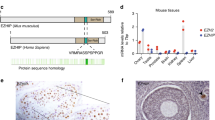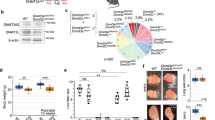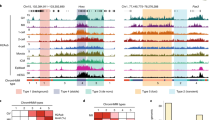Abstract
Blimp1, a transcriptional repressor, has a crucial role in the specification of primordial germ cells (PGCs) in mice at embryonic day 7.5 (E7.5)1,2. This SET–PR domain protein can form complexes with various chromatin modifiers in a context-dependent manner3,4. Here, we show that Blimp1 has a novel interaction with Prmt5, an arginine-specific histone methyltransferase, which mediates symmetrical dimethylation of arginine 3 on histone H2A and/or H4 tails (H2A/H4R3me2s). Prmt5 has been shown to associate with Tudor, a component of germ plasm in Drosophila melanogaster5. Blimp1–Prmt5 colocalization results in high levels of H2A/H4 R3 methylation in PGCs at E8.5. However, at E11.5, Blimp1–Prmt5 translocates from the nucleus to the cytoplasm, resulting in the loss of H2A/H4 R3 methylation at the time of extensive epigenetic reprogramming of germ cells6. Subsequently, Dhx38, a putative target of the Blimp1–Prmt5 complex, is upregulated. Interestingly, expression of Dhx38 is also seen in pluripotent embryonic germ cells that are derived from PGCs when Blimp1 expression is lost. Our study demonstrates that Blimp1 is involved in a novel transcriptional regulatory complex in the mouse germ-cell lineage.
This is a preview of subscription content, access via your institution
Access options
Subscribe to this journal
Receive 12 print issues and online access
$209.00 per year
only $17.42 per issue
Buy this article
- Purchase on Springer Link
- Instant access to full article PDF
Prices may be subject to local taxes which are calculated during checkout





Similar content being viewed by others
References
Ohinata, Y. et al. Blimp1 is a critical determinant of the germ cell lineage in mice. Nature 436, 207–213 (2005).
Vincent, S. D. et al. The zinc finger transcriptional repressor Blimp1/Prdm1 is dispensable for early axis formation but is required for specification of primordial germ cells in the mouse. Development 132, 1315–1325 (2005).
Yu, J., Angelin-Duclos, C., Greenwood, J., Liao, J. & Calame, K. Transcriptional repression by blimp-1 (PRDI–BF1) involves recruitment of histone deacetylase. Mol. Cell. Biol. 20, 2592–2603 (2000).
Gyory, I., Wu, J., Fejer, G., Seto, E. & Wright, K. L. PRDI–BF1 recruits the histone H3 methyltransferase G9a in transcriptional silencing. Nature Immunol. 5, 299–308 (2004).
Anne, J. & Mechler, B. M. Valois, a component of the nuage and pole plasm, is involved in assembly of these structures, and binds to Tudor and the methyltransferase Capsuleen. Development 132, 2167–2177 (2005).
Hajkova, P. et al. Epigenetic reprogramming in mouse primordial germ cells. Mech. Dev. 117, 15–23 (2002).
Surani, M. A. et al. Mechanism of mouse germ cell specification: a genetic program regulating epigenetic reprogramming. Cold Spring Harb. Symp. Quant. Biol. 69, 1–9 (2004).
Ginsburg, M., Snow, M. H. & McLaren, A. Primordial germ cells in the mouse embryo during gastrulation. Development 110, 521–528 (1990).
Lachner, M., O'Sullivan, R. J. & Jenuwein, T. An epigenetic road map for histone lysine methylation. J. Cell Sci. 116, 2117–2124 (2003).
Erhardt, S. et al. Consequences of the depletion of zygotic and embryonic enhancer of zeste 2 during preimplantation mouse development. Development 130, 4235–4248 (2003).
Tachibana, M. et al. G9a histone methyltransferase plays a dominant role in euchromatic histone H3 lysine 9 methylation and is essential for early embryogenesis. Genes Dev. 16, 1779–1791 (2002).
Shaffer, A. L. et al. Blimp-1 orchestrates plasma cell differentiation by extinguishing the mature B cell gene expression program. Immunity 17, 51–62 (2002).
Shapiro-Shelef, M. et al. Blimp-1 is required for the formation of immunoglobulin secreting plasma cells and pre-plasma memory B cells. Immunity 19, 607–620 (2003).
Ren, B., Chee, K. J., Kim, T. H. & Maniatis, T. PRDI–BF1–Blimp-1 repression is mediated by corepressors of the Groucho family of proteins. Genes Dev. 13, 125–137 (1999).
Rea, S. et al. Regulation of chromatin structure by site-specific histone H3 methyltransferases. Nature 406, 593–599 (2000).
Strahl, B. D. et al. Methylation of histone H4 at arginine 3 occurs in vivo and is mediated by the nuclear receptor coactivator PRMT1. Curr. Biol. 11, 996–1000 (2001).
Wang, H. et al. Methylation of histone H4 at arginine 3 facilitating transcriptional activation by nuclear hormone receptor. Science 293, 853–857 (2001).
Pal, S., Vishwanath, S. N., Erdjument-Bromage, H., Tempst, P. & Sif, S. Human SWI/SNF-associated PRMT5 methylates histone H3 arginine 8 and negatively regulates expression of ST7 and NM23 tumor suppressor genes. Mol. Cell. Biol. 24, 9630–9645 (2004).
Bedford, M. T. & Richard, S. Arginine methylation an emerging regulator of protein function. Mol. Cell 18, 263–272 (2005).
Wang, Y. et al. Human PAD4 regulates histone arginine methylation levels via demethylimination. Science 306, 279–283 (2004).
Seki, Y. et al. Extensive and orderly reprogramming of genome-wide chromatin modifications associated with specification and early development of germ cells in mice. Dev. Biol. 278, 440–458 (2005).
Weinmann, A. S., Bartley, S. M., Zhang, T., Zhang, M. Q. & Farnham, P. J. Use of chromatin immunoprecipitation to clone novel E2F target promoters. Mol. Cell. Biol. 21, 6820–6832 (2001).
Oberley, M. J., Inman, D. R. & Farnham, P. J. E2F6 negatively regulates BRCA1 in human cancer cells without methylation of histone H3 on lysine 9. J. Biol. Chem. 278, 42466–42476 (2003).
Graham, P. L. & Kimble, J. The mog-1 gene is required for the switch from spermatogenesis to oogenesis in Caenorhabditis elegans. Genetics 133, 919–931 (1993).
Kuo, T. C. & Calame, K. L. B lymphocyte-induced maturation protein (Blimp)-1, IFN regulatory factor (IRF)-1, and IRF-2 can bind to the same regulatory sites. J. Immunol. 173, 5556–5563 (2004).
Fabbrizio, E. et al. Negative regulation of transcription by the type II arginine methyltransferase PRMT5. EMBO Rep. 3, 641–645 (2002).
Sarmento, O. F. et al. Dynamic alterations of specific histone modifications during early murine development. J. Cell Sci. 117, 4449–4459 (2004).
Bannister, A. J. et al. Selective recognition of methylated lysine 9 on histone H3 by the HP1 chromo domain. Nature 410, 120–124 (2001).
Cote, J. & Richard, S. Tudor domains bind symmetrical dimethylated arginines. J. Biol. Chem. 13, 13 (2005).
Saitou, M., Barton, S. C. & Surani, M. A. A molecular programme for the specification of germ cell fate in mice. Nature 418, 293–300 (2002).
Acknowledgements
We are most grateful to M. E. T. Padilla for thoughtful discussions and also for advice concerning the ChIP cloning. We thank S.J. Jeffries for help with the bioinformatics and C. Lee for help with animals and dissection of embryos. We thank A. Brehm, K. Calame, W. Herr and T. Nakano for providing reagents; and L. Schaeffer and E. Goillot for critical reading of the manuscript. K.A. was a recipient of a Marie Curie (PRZ/OO4/RG32856) and a Newton Trust (PRZ/008/RG38647) fellowship, and U.C.L was supported by a Wellcome Trust PhD studentship. This work was funded by grants from the Cancer Research UK to T.K. and by the Wellcome Trust to M.A.S.
Author information
Authors and Affiliations
Corresponding author
Ethics declarations
Competing interests
The authors declare no competing financial interests.
Supplementary information
Supplementary Information
Supplementary Figures S1, S2, S3 and S4 (PDF 728 kb)
Rights and permissions
About this article
Cite this article
Ancelin, K., Lange, U., Hajkova, P. et al. Blimp1 associates with Prmt5 and directs histone arginine methylation in mouse germ cells. Nat Cell Biol 8, 623–630 (2006). https://doi.org/10.1038/ncb1413
Received:
Accepted:
Published:
Issue Date:
DOI: https://doi.org/10.1038/ncb1413
This article is cited by
-
PRMT5 confers lipid metabolism reprogramming, tumour growth and metastasis depending on the SIRT7-mediated desuccinylation of PRMT5 K387 in tumours
Acta Pharmacologica Sinica (2022)
-
Oxygen-sensitive methylation of ULK1 is required for hypoxia-induced autophagy
Nature Communications (2022)
-
Ascorbic acid and all-trans retinoic acid promote proliferation of chicken blastoderm cells (cBCs) by mediating DNA demethylation
In Vitro Cellular & Developmental Biology - Animal (2022)
-
Association study between single-nucleotide variants rs12097821, rs2477686, and rs10842262 and idiopathic male infertility risk in Serbian population with meta-analysis
Journal of Assisted Reproduction and Genetics (2020)
-
Differential epigenetic regulation between the alternative promoters, PRDM1α and PRDM1β, of the tumour suppressor gene PRDM1 in human multiple myeloma cells
Scientific Reports (2020)



